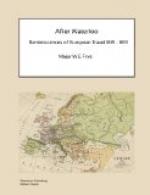In the evening I visited the theatre built by Bibbiena and had the pleasure of hearing for the first time an Italian tragedy, which, however, are now rarely represented and scarcely ever well acted. This night’s performance formed an exception and was satisfactory. The piece was Romeo and Giulietta. The actress who did the part of Giulietta performed it with great effect, particularly in the tomb scene. In this scene she reminded me forcibly of our own excellent actress, Miss O’Neill. This was the only part of the play that had any resemblance to the tragedy of Shakespeare. All the rest was on the French model. I saw a number of beautiful women in the boxes. The Bolognese women are remarkable for their fine complexions; those that I saw were much inclined to embonpoint.
[79] And also to Napoleon, after the battle at Eylau.—ED.
[80] Joseph Forsyth (1763-1815), author of Remarks
on antiquities, arts
and letters in Italy,
London, 1813.—ED.
[81] Horace, Carm., II, I, 33.—ED.
[82] The young woman in question was Clotilda Tambroni
(1768-1818). She
taught Greek at the University
of Bologna and was in correspondence
with the great French scholar
Ansse de Villoison.—ED.
CHAPTER IX
Journey across the Appennines to Florence—Tuscan idioms and customs—Monuments and galleries at Florence—The Cascino—Churches— Theatres—Popularity of the Grand Duke—Napoleon’s downfall not regretted—Academies in Florence.
FLORENCE, 26th August.
The moment you leave Bologna to go to Florence you enter the gorges of the Appennines, and after journeying seven miles, begin to ascend the ridge. The ascent begins at Pianoro. Among these mountains the scenery is wild and romantic, and tho’ not so grandiose and sublime as that of the Alps, is nevertheless extremely picturesque. One meets occasionally with the ruins of old castles on some of the heights, and I was strongly reminded, at the sight of these antique edifices, of the mysteries of Udolpho and the times of the Condottieri. The silence that reigns here is only interrupted by the noise of the waterfall and the occasional scream of the eagle. The wild abrupt transition of landscape would suggest the idea of haunting places for robbers, yet one seldom or never hears of any, on this road. In Tuscany there is, I understand, so much industry and morality, that a robbery is a thing unknown; but in his Holiness’s dominions, from the idleness and poverty that prevails, they are said to be frequent. Why it does not occur in these mountains, in that part of them, at least, which belongs to the Papal Government, I am at a loss to conceive.




